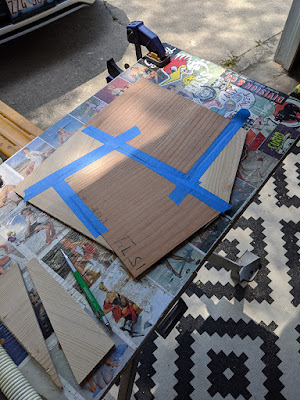IS COMPLEXITY A YOUNG MAN’S GAME?
I was supposed to be writing about building the Mark I and Mark II basses, but it’s turned into me writing about what I was thinking about while building them.
So to continue in that fashion:
I’ve always had a tendency to make rather grand gestures while performing music. I took a jazz improvisation (for trumpet) class in college (it was a real turning point for me in my playing, mainly that I wasn’t much of a trumpet player). One example though: the teacher says everyone look at Donovan while he takes a solo here. Now that everyone was looking my way I made sure to really ham it up—entertain the people! After finishing up my twelve bars the teacher says to the group: “don’t do that,” at least that was the gist of it. The lesson being taught was that all the face contortions only make things harder. Things like intonation, flexibility, tone—musicality.
Jazz guys have a tendency to keep things cool, while their rock n roll counterparts are running around and jumping. In recent years I’ve started taking note of the different roles in a band. I’ve also started playing shows with older guys. I’ve locked into the ‘old-timer on bass.’ The old-timer on bass appears almost perfectly still, but produces tons of sound and is always in the pocket. It is efficiency of motion at it’s finest and the grand gestures are sonic, not physical.
I suppose we all get old and the appeal of jumping off a bass cabinet wanes. Maybe the youngster over-complicates the task at hand. Maybe you need to over-complicate things in order to find the simple solution. Perhaps the oldster finds dynamism in stillness. The musical performance version of Tai-Chi vs. the WWE.
To start to tie in last week’s tangent to this build I go back to the Bukowski quote. You can look at it negatively in that we become more conventional or conservative as we age. Or, it could mean that with age we finally start to simplify and cut the bullshit. In that sense, it’s about refinement, the road towards perfection.
THE LESSON IS TAUGHT SEVERAL TIMES BEFORE THE LESSON IS LEARNED
Well I think all this reminiscing I was doing while working on the MARK I got me over-complicating things—too many ideas in one package. Although I think I still managed to over-complicated the MARK II, I started with good intentions.
I always like to have a 2x4 in the garage, they come in quite handy and you can really build anything out of them. I remembered this thing Tom Waits said on a talk show:
"I have a guitar made out of a 2x4 that I bought in Cleveland. You know, in Iraq, you can't have a guitar in the window of a music store because it's too sexy. You know, the curves. So I could go over there with these 2x4 guitars and really take the country by storm.”
I didn't go out and buy any new lumber, but I had some good stuff around. The body core is made up of your standard pine 2x4. The top is 1/4" sitka spruce and the back is 1/4" red grandis. Red grandis is considered a substitute for american mahogany. It's a bit cheaper, is really wonderful to work with and looks great with an oil finish.
KEEP IT STUPID SIMPLE… or do I have that backwards?
Often times a simple solution is the result of a complicated path. Life is the accumulation of experience. The MARK II needed the MARK I in order to happen. One of the requirements with both of these builds was to use what I already had. I’m not trying to accumulate more materials. This along with collage-sketching led to (what I think is) a pretty exciting idea: wood-quilting.
In simplicity I believe there is also a sense of practicality and maybe even conservation. That’s where my version of wood quilting exists (I say my version because this is not a new idea). It would certainly be easier to go out and buy a large piece of sitka to cut a guitar top. That would be a simple solution. There is also a simplicity in looking around at what you have and making it work.
This idea really struck me with the sketch above (I was planning out a simplified version of the MARK II—streamline and simplify), but I had spent a fair amount of time this summer looking at these sitka cutoffs on the garage floor. I kept thinking it would be nice to do something with these. For one, sometimes the cutoffs make interesting shapes and secondly it's not an inexpensive wood. I decided before giving this a try as a guitar top, I would try it out as a pickguard. The MARK II pickguard is mainly douglas fir with some sitka spruce. The MARK II gave me the opportunity to have a go at this idea and learn a few things:
- Glue in stages! (take your time, be patient)
- Reinforce seams, especially end grain seams. (likely a bigger concern for thinner pieces of lumber)
- Don’t get too fussy with the finishing. (perhaps a general note, however the different directions of grain add some complexity to the sanding)














Comments